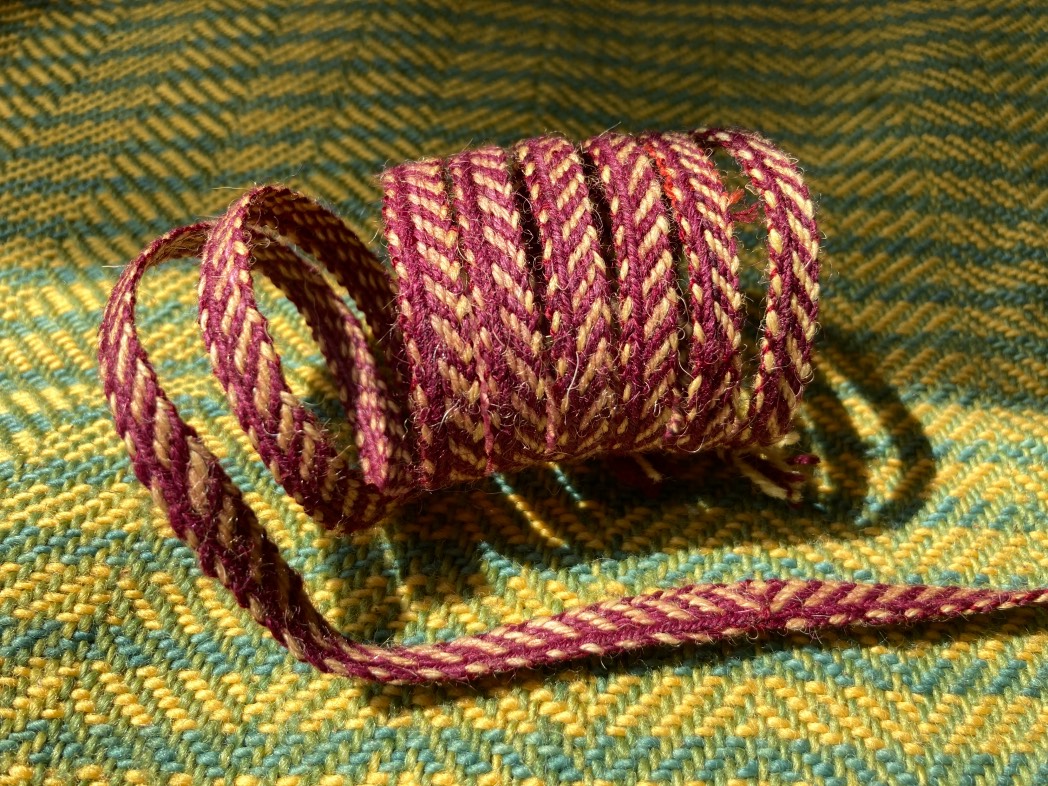
Die brettchengewebte Borte aus dem frühkaiserzeitlichen Mainz
Das Textilfragment mit der Bezeichnung R61, 3 ist seit 1857 im Besitz des Mainzer Landesmseums. Sie wird in das 1. Jahrhunderts v. Chr. Bis zum 3. Jahrhundert n. Chr. datiert.
Gefunden wurde das Textil im Rautenköper mit einer angenähten Brettchenborte auf dem Schillerplatz in Mainz.
Über die ursprüngliche Verwendung ist nichts bekannt.
The textile fragment with the designation R61, 3 has been in the possession of the Mainz Landesmseum since 1857. It is dated to the 1st century BC to the 3rd century AD.
The textile was found in a diamond twill with a tablet border sewn on at the Schillerplatz in Mainz.
Nothing is known about its original use.
Es handelt sich hier um um ein Textil, an das eine kleine Borte als Anfangskannte angenäht worden war. Die Borte selbst ist auf einer Länge von 9,7 cm gut erhalten. Es ist etwa 0,6 cm breit. Und man kann gut erkennen, dass es ein zweifarbiges Streifenmuster gab. Mehr konnte man von den Farben nicht erkennen und so habe ich mich für Rot und Gelb als klassische Kombination entschieden. Farbanalysen gibt es immer noch nicht, aber die Farben der Borte wird als Sepiabraun und hellem Beige rot beschrieben.
It is a textile to which a small border had been sewn as the initial edge. The border itself is well preserved over a length of 9.7 cm. It's approx 0,6 cm wide. And you can see well that there was a two-coloured stripe pattern. That was all you could make out of the colours, so I decided on red and yellow as the classic combination. Colour analyses are still not available, but the colours of the border are described as sepia brown and light beige red.

John-Peter Wild hatte 1982 erstmalig eine Rekonstruktionszeichnung von der Borte veröffentlicht, mit der ich persönlich allerdings nichts anfangen konnte.
Erst als ich 2018 die Gelegenheit hatte, die Borte im Archiv des Museums zu betrachten, machte es bei mir 'klick'.
John-Peter Wild had first published a reconstruction drawing of the border in 1982, but I personally couldn't do anything with it.
It was only when I had the opportunity to look at the band in the museum's archives in 2018 that it 'clicked' for me.

Der Hintergrung ist übrigens auch eine Nachwebung aus Mainz, Mainz, Emmeransstraße 8, kaiserzeitlich R 4091, Danke an Marled.
Incidentally, the background is also a re-weaving from Mainz, Mainz, Emmeransstraße 8, imperial period R 4091, thanks to Marled.
Es ist ein feines Band, das mit 6 Brettchen gewebt wurde. 5 davon wurden mit 2 Fäden pro Brettchen bezogen, 1 mit 4 Brettchen. Der Aufzug ist absolut untypisch für sonst gefundene Brettchenborten.
Das Muster entsteht hier, indem alle Brettchen kontinuierlich in eine Richtung gedreht werden. Die unterschiedliche Brettchenstellung ist notwendig, damit man eine glatte Borte hat, würde mann alle Brettchen in Z aufketten, dann würde die Borte sich in sich verdrehen.
It is a fine band woven with 6 tablets. 5 of them were covered with 2 threads per tablet, 1 with 4 tablets. The threading is absolutely atypical of board borders found elsewhere.
The pattern is created here by continuously turning all the tablets in one direction. The different position of the tablets is necessary to have a smooth border, if you were to thread all the tablets in Z, the border would twist in on itself.

Ich habe meine Version mit 16/2 Wolle gewebt und das Band ist 0,7-0,8 cm breit.
Als ich die Borte 2018 gab es noch nirgendwo eine Abbildung zum Vergleich. Inzwischen hat Sylvia Mitschike eine wirklich tolle Publikation zu allen Funden aus Mainz veröffentlicht.
I wove my version with 16/2 wool and the band is 0.7-0.8 cm wide.
When I made the border in 2018, there was no illustration anywhere for comparison. In the meantime, Sylvia Mitschike has published a really great publication on all the finds from Mainz.
Literatur:
Mitschke Sylvia, Material und Verarbeitung textiler Rohstoffe in der römischen Epoche
am Beispiel der Funde aus Mainz, 2021
John Peter Wild, Some new light on Roman textiles, NESAT I, 1982
Böhme-Schönberger Astrid, Hautnah - Römische Stoffe aus Mainz, 2009
